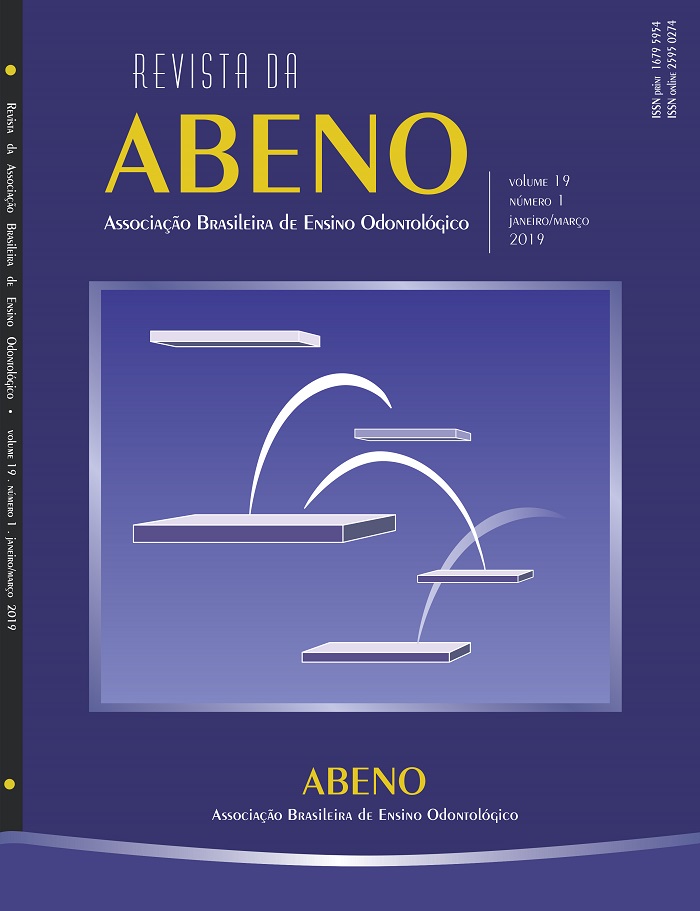Comparison of different teaching strategies to improve the knowledge of Dental students about prescribing standards
DOI:
https://doi.org/10.30979/rev.abeno.v19i1.655Keywords:
Dental education. Prescription. Dentistry. Teaching.Abstract
The aim of this study was to evaluate different teaching strategies to improve the knowledge of dental students about prescribing standards. We evaluated 72 students who were randomly separated into 3 groups (n = 24): Group 1 - at each evaluation stage, an explanatory video about prescription rules was presented; Group 2 - the same video was made available on a virtual platform (with unlimited access); Group 3 - control: the students did not have additional activities on the subject. During the study period 4 evaluations were performed, and all participants received a different clinical case to carry out a prescription for the proposed clinical situation. For each prescription performed, a score was given to different items: identification of professional and patient, concentration, dosage and quantity of the medicine, instructions, among others. The results were submitted to statistical analysis and the level of significance was set at 5%. No significant differences were observed at baseline between groups (p> 0.05). However, after using the strategies better results were observed for G1 when compared with G2 and G3 (p<0.05). It could be concluded that among the strategies used, the use of video was the one that provided an improvement in knowledge of dental students in relation to prescribing standards.Downloads
References
Donaldson LJ, Kelley ET, Dhingra-Kumar N, Kieny MP, Sheikh A. Medication without harm: WHO’s Global Patient Safety Challenge. Lancet. 2017;39(10080):1680-1.
Ramacciato J, Motta RHL. Terapêutica Medicamentosa na Implantodontia. In: Perri PS, Pellizer EP. Fundamentos em Implantodontia - uma visão contemporânea. 2a ed. São Paulo: Quintessence; 2015.
Meiners MMMA, Bergsten-Mendes G. Prescrição de medicamentos para crianças hospitalizadas: como avaliar a qualidade? Rev Assoc Med Bras. 2001;47(4):332-7.
Armonia LP, Rocha RG. Como prescrever em Odontologia – marcas e genéricos. 9a ed. São Paulo: Santos; 2011.
Araújo LG, Biagini FC, Fernandes RL, Caputo IGC, Silva RHA. Conhecimento de acadêmicos de Odontologia sobre os aspectos clínicos, éticos e legais da prescrição medicamentosa. RFO UPF. 2012; 17(1):50-4.
Néri ED. Erros de prescrição de medicamentos em um hospital brasileiro. Rev Assoc Med Bras. 2011;57(3):306-14.
Ganashree P, Bhuvana K, Sarala N. Critical review of drug promotional literature using the World Health Organization guidelines. J Res Pharm Pract. 2016 Jul- Sep;5(3):162-5.
Cunha FL, Penna LAP, Soares HA, Varella MA. Anvisa eo Cirurgião- Dentista: do controle de qualidade de insumos às normas de prescrição de antimicrobianos. Rev Assoc Cir Paul Dent. 2011;65(4):252-7.
Castilho LS, Paixão HH, Perini E. Prescrição de medicamentos de uso sistêmico po cirurgiões-dentistas, clínicos gerais Rev Saúde Pública.1999;33(3):287-94.
Carvalho VA, Borgatto AF Lopes LC. Knowledge level for prescription of nonsteroidal anti-inflammatory by dentists in São José dos Campos, São Paulo State, Brazil. Ciênc Saude Colet. 2010;15 Suppl 1:1773-82.
Jain A, Gupta D, Singh D, Garg Y, Saxena A, Chaudhary H, et al. Knowledge regarding prescription of drugs among dental students: a descriptive study. J Basic Clin Pharm. 2015;7(1):12-6.
Martín-Jiménez M, Martín-Biedma B, López-López J, Alonso-Ezpeleta O, Velasco-Ortega E, Jiménez-Sánchez MC, et al. Dental students’ knowledge regarding the indications for antibiotics in the management of endodontic infections. Int Endod J. 2018;51(1):118-27.
Oberoi SS, Dhingra C, Sharma G, Sardana D. Antibiotics in dental practice: how justified are we. Int Dent J. 2015;65(1):4-10.
Pereira FM, Araújo MDO, Silva DRS, Santos AS, Lira EM, Nascimento LS. Antibiotic prophylaxis in Dentistry: a teaching experience using conceptual maps. Rev ABENO. 2018;18(1):155-160.
Moura CS, Naves JOS, Coelho EB, Lia EN. Assessment of quality of prescription by dental students. J Appl Oral Sci 2014;22(3):204-8.
Gelal A, Gumustekin M, Arici MA, Gidener S. Rational pharmacotherapy training for fourth-year medical students. Indian J Pharmacol. 2013;45(1):4-8.
Akram A, Zamzam R, Mohamad NB, Abdulah D, Meerah SM. An assessment of the prescribing skills of undergraduate dental students in Malaysia. J Dent Educ. 2012;76:1527-31.
Gadbury-Amyot CC, Singh AH, Overman PR. Teaching with technology: learning outcomes for a combined dental and dental hygiene online hybrid oral histology course. J Dent Educ. 2013;77(6):732-43.
Gonzalez SM, Gadbury-Amyot CC. Using Twitter for teaching and learning in na Oral and Maxillofacial Radiology Course. J Dent Educ. 2016;80(2):149-55.
Barbosa ACS, Oliveira CVC, Gueiros MCN, Lima MC, Vasconcelos MMB, Caldas Júnior AF. Uso da tecnologia educacional web-based por profissionais da Odontologia brasileira. Rev ABENO. 2018;18(1):23-33.
Kamarudin G, Penm J, Chaar B, Moles R. Educational interventions to improve prescribing competency: a systematic review. BMJ Open. 2013;30;3(8):e003291.
Downloads
Published
How to Cite
Issue
Section
License
Autores que publicam nesta revista concordam com os seguintes termos:
a) Autores mantém os direitos autorais e concedem à revista o direito de primeira publicação, com o trabalho simultaneamente licenciado sob a Licença Creative Commons Attribution que permite o compartilhamento do trabalho com reconhecimento da autoria e publicação inicial nesta revista.
b) Autores têm autorização para assumir contratos adicionais separadamente, para distribuição não-exclusiva da versão do trabalho publicada nesta revista (ex.: publicar em repositório institucional ou como capítulo de livro), com reconhecimento de autoria e publicação inicial nesta revista.
c) Autores têm permissão e são estimulados a publicar e distribuir seu trabalho online (ex.: em repositórios institucionais ou na sua página pessoal) a qualquer ponto antes ou durante o processo editorial, já que isso pode gerar alterações produtivas, bem como aumentar o impacto e a citação do trabalho publicado (Veja O Efeito do Acesso Livre).






